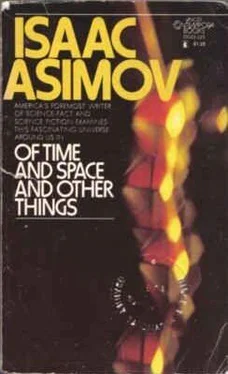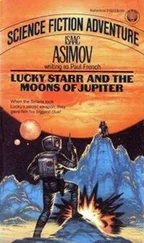Isaac Asimov - Of Time and Space and Other Things
Здесь есть возможность читать онлайн «Isaac Asimov - Of Time and Space and Other Things» весь текст электронной книги совершенно бесплатно (целиком полную версию без сокращений). В некоторых случаях можно слушать аудио, скачать через торрент в формате fb2 и присутствует краткое содержание. Год выпуска: 1972, ISBN: 1972, Издательство: Lancer Books, Жанр: Прочая научная литература, на английском языке. Описание произведения, (предисловие) а так же отзывы посетителей доступны на портале библиотеки ЛибКат.
- Название:Of Time and Space and Other Things
- Автор:
- Издательство:Lancer Books
- Жанр:
- Год:1972
- ISBN:ISBN: 0-447-33023-3
- Рейтинг книги:4 / 5. Голосов: 1
-
Избранное:Добавить в избранное
- Отзывы:
-
Ваша оценка:
- 80
- 1
- 2
- 3
- 4
- 5
Of Time and Space and Other Things: краткое содержание, описание и аннотация
Предлагаем к чтению аннотацию, описание, краткое содержание или предисловие (зависит от того, что написал сам автор книги «Of Time and Space and Other Things»). Если вы не нашли необходимую информацию о книге — напишите в комментариях, мы постараемся отыскать её.
Of Time and Space and Other Things — читать онлайн бесплатно полную книгу (весь текст) целиком
Ниже представлен текст книги, разбитый по страницам. Система сохранения места последней прочитанной страницы, позволяет с удобством читать онлайн бесплатно книгу «Of Time and Space and Other Things», без необходимости каждый раз заново искать на чём Вы остановились. Поставьте закладку, и сможете в любой момент перейти на страницу, на которой закончили чтение.
Интервал:
Закладка:
Then came 1905, and in that year a 26-year-old theo retical physicist, Albert Einstein, published fivo separate scientific papers on three subjects, any one of which would have been enough to establish him as a first-magnitude star in the scientific heavens.
In two, he worked out the theoretical basis for "Brown ian motion" and, incidentally, produced the machinery by which the actual size of atoms could be established for the first time. It was one of these papers that earned him his Ph.D.
In the third paper, he dealt with the "photoelectric effect" and showed that although Classical Physics could not explain it, Planck's quantum theory could.
This really startled physicists. Planck had invented quanta merely to account for black-body radiation, and here it turned out to explain the photoelectric effect, too, something entirely different. For quanta to strike in two different places like this, it seemed suddenly very reason able to suppose that they (or something very like them) actually existed.
(Einstein's fourth and fifth papers set up a new view of the universe which we call "The Special Theory of Rela tivity." It is in these papers that he introduced his famous equation e = MC2; see Chapter 13.
These papers on relativity, expanded into a "General Theory" in 1915, are the achievements for which Einstein is known to people outside the world of physics. Just the same, in 1921, when he was awarded the Nobel Prize for Physics, it was for his work on the photoelectric effect and not for his theory of relativity.)
The value of h is so incredibly small that in the ordinary world we can ignore it. The ordinary gross events of everyday life can be considered as though energy were a continuum. This is a good "first approximation."
However, as we deal with smaller and smaller energy changes, the quantum steps by which those changes'must take place become larger and larger in comparison. Thus, a flight of stairs consisting of treads 1 millimeter high and 3 millimeters deep would seem merely a slightly roughened ramp to a six-foot man. To a man the size of an ant, how ever, the steps would seem respectable individual obstacles to be clambered over with difficulty. And to a man the size of a bacterium, they would be mountainous precipices lin the same way, by the time we descend into the world within the atom the quantum step has become a gigantic thing. Atomic physics cannot, therefore, be described in Classical terms, not even as an approximation.
The first to realize this clearly was the Danish physicist Niels Bohr. In 1913 Bohr pointed out that if an electron absorbed energy, it had to absorb it a whole quantum at a time and that to an electron a quantum was a large piece of en 'ergy that forced it to change its relationship to the rest of the atom drastically and all at once.
Bohr pictured the electron as circling the atomic nucleus in a fixed orbit. When it absorbed a quantum of energy, it suddenly found itself in an orbit farther from the nucleus - there was no in-between, it was a one-step proposition.
Since only certain orbits were possible, according to Bohr's treatment of the subject, only quanta of certain size could be absorbed by the atom-only quanta large enoug to raise an electron from one permissible orbit to another.
When the electrons dropped back down the line of per missible orbits, they emitted radiations in quanta. They emitted just those frequencies which went along with the size of quanta they could emit in going from one orbit to another.
In this way, the science of spectroscopy was rational ized. Men understood a little more deeply why each ele ment (consisting of one type of atom with one type of energy relationships among the electrons making up that type of atom) should radiate certain frequencies, and cer tain frequencies only, when incandescent. They also under stood why a substance that could,absorb certain frequen cies should also emit those same frequencies under other circumstances.
In other words, Yirchhoff had started the whole problem and now it had come around fuil-circle to place his em pirical discoveries on a rational basis.
Bohr's initial picture was oversimple; but he and other men gradually made it more complicated, and capable of explaining finer and finer points of observation. Finally, in 1926, the Austrian physicist Erwin Schri3dinger worked out a mathematical treatment that was adequate to an alyze the workings of the particles making up the interior of the atom according to the principles of the quantum theory. This was called "quantum mechanics," as opposed to the "classical mechanics" based on Newton's three laws of motion and it is quantum mechanics that is the founda- tion of Modern Physics.
15. Welcome, Stranger!
There are fashions in science as in everything else. Con duct an experiment that brings about an unusual success and before you can say, "There are a dozen imitations!" there are a dozen imitations!
Consider the element xenon (pronounced zee'non), dis covered in 1898 by William Ramsay and Morris William Travers. Like other elements of the same type it was iso lated from liquid air. The existence of these elements in air had remained unsuspected through over a century of ardent chemical analysis of the air, so when they finally dawned upon the chemical consciousness they were greeted as strange and unexpected newcomers. Indeed, the name, xenon, is the neutral form of the Greek word for "strange," so that xenon is "the strange one" in all literalness.
Xenon belongs to a group of elements commonly known as the "inert gases" (because they are chemically inert) or the "rare gases" (because they are rare), or "noble gases" because the standoffishness that results from chemi cal inertness seems to indicate a haughty sense of seff importance.
Xenon is the rarest of the stable inert gas and, as a matter of fact, is the rarest of all the stable elements on Earth. Xenon occurs only in the atmosphere, and there it makes up about 5.3 parts per million by weight. Since the atmosphere weighs about 5,500,000,000,000,000 (five and a half quadrillion) tons, this means that the planetary supply of xenon comes to just about 30,000,000,000 (thirty billion) tons. This seems ample, taken in full, but picking xenon atoms out of the overpoweringly more corn,mon constituents of the atmosphere is an arduous task and so xenon isn't a common substance and never will be.
What with one thing and another, then, xenon was not a popular substance in the chemical laboratories. Its chem ical, physical, and nuclear properties were worked out, but beyond that there seemed little worth doing with it. It remained the little strange one and received cold shoulders and frosty smiles.
Then, in 1962, an unusual experiment involving xenon was announced whereupon from all over the world broad smiles broke out across chemical countenances, and little xenon was led into the test tube with friendly solicitude.
"Welcome, stranger!" was the cry everywhere, and now you can't open a chemical journal anywhere without find ing several papers on xenon.
What happened?
If you expect a quick answer, you little know me. Let me take my customary route around Robin Hood's barn and begin by stating, first of all, that xenon is a gas.
Being a gas is a matter of accident. No substance is a gas intrinsically, but only insofar as temperature dictates.
On Venus, water and ammonia are both gases. On Earth, ammonia is a gas, but water is not. On Titan, neither am monia nor water are gases.
So I'll have to set up an arbitrary criterion to suit my present purpose. Let's say that any substance that remains a gas at -1000 C. (-148' F.) is a Gas with a capital letter, and concentrate on those. This is a temperature that is never reached on Earth, even in an Antarctic winter of extraordinary severity, so that no Gas is ever anything but gaseous on Earth (except occasionally in chemical lab oratories).
Читать дальшеИнтервал:
Закладка:
Похожие книги на «Of Time and Space and Other Things»
Представляем Вашему вниманию похожие книги на «Of Time and Space and Other Things» списком для выбора. Мы отобрали схожую по названию и смыслу литературу в надежде предоставить читателям больше вариантов отыскать новые, интересные, ещё непрочитанные произведения.
Обсуждение, отзывы о книге «Of Time and Space and Other Things» и просто собственные мнения читателей. Оставьте ваши комментарии, напишите, что Вы думаете о произведении, его смысле или главных героях. Укажите что конкретно понравилось, а что нет, и почему Вы так считаете.












